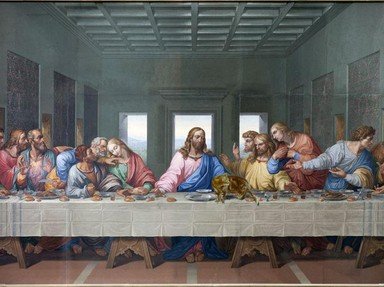Quiz Answer Key and Fun Facts
1. Art historians have long supported the idea that the subject for the "Mona Lisa" (c. 1503-1506) is Lisa Gherardini, wife of silk merchant Francesco del Giocondo. One argument is that the common title of the painting, "Mona Lisa", matches the first name of the subject. Another is the alternative Italian title, "La Gioconda", which means "the jocund one". Why do art historians believe this title helps prove that Lisa Gherardini is the true subject?
2. Like many Renaissance artists, Leonardo spent most of his painting efforts on either portraits or religious art. "The Last Supper" (1490s) is one of the most recognized examples of religious art, and it has also become one of the most damaged, with artists over the centuries attempting to restore it (poorly) many times and other catastrophes befalling it. Which of these was NOT a way in which "The Last Supper" was damaged?
3. Cecilia Gallerani, a mistress of Leonardo da Vinci's patron, the duke of Milan, can be seen holding what animal in this painting?
4. It was sold for $450.3 million (U.S.) in 2017, breaking the record for the most expensive painting ever sold. Making the sign of the cross and holding a non-refracting orb, Jesus is shown in which painting wearing Renaissance garb?
5. Leonardo da Vinci's studies in the field of optics led him to a certain art technique that depicted softened outlines, making the transition between colors less pronounced. His painting "Virgin of the Rocks" (1483-1486) was said to be a perfect example of which technique that he described as "without lines or borders, in the manner of smoke or beyond the focus plane"?
6. Having two sonnets written about her by Lorenzo de' Medici himself, the beautiful Ginevra de' Benci was the subject of this portrait by Leonardo da Vinci (c. 1474-1478). It is most likely a portrait painted for her betrothal considering the way she is facing. The plant in the background was chosen purposefully as it represented female virtue in Renaissance Italy and also had the benefit of being similar to Ginevra's name (in Italian). What plant is it?
7. Only about 20 of Leonardo da Vinci's works are still in existence, while some have been lost to history. This work titled "Portrait of a Musician" (c. 1485-1490) depicts a man holding sheet music, and there is little evidence and even less consensus over who the painting's subject is. Some have even debated whether Leonardo painted it himself. Which world leader stole the painting in 1796 and hung it in the Louvre, claiming it was painted by Bernardino Luini?
8. Leonardo earned his first moment of recognition when he helped his master paint "The Baptism of Christ" (1472-75). Who was this Florentine, who also trained Sandro Botticelli, Francesco Botticini, and Lorenzo di Credi?
9. What was then a 1,500-year-old text was the inspiration behind Leonardo da Vinci's "Vitruvian Man".
10. This painting is believed to have been Leonardo da Vinci's last, and it depicts a well-known religious figure that had up until that point been mostly painted as a thin, ascetic figure. Which religious figure is it?
Source: Author
trident
This quiz was reviewed by FunTrivia editor
looney_tunes before going online.
Any errors found in FunTrivia content are routinely corrected through our feedback system.
